At the time of its release back in 2013, Sigma’s 18-35mm f/1.8 ART zoom was a revelation. Not only did it boast a previously unheard of maximum aperture for a large sensor zoom, it also offered superb, prime-like image quality alongside the convenience of having multiple focal lengths in one relatively compact lens.
As with the rest of Sigma’s impressive ART line, the 18-35mm offers excellent build quality with an affordable price tag. The company’s first f1.8 zoom lens quickly became an instant hit with shooters and is now a well established staple of the video professional’s kit bag.
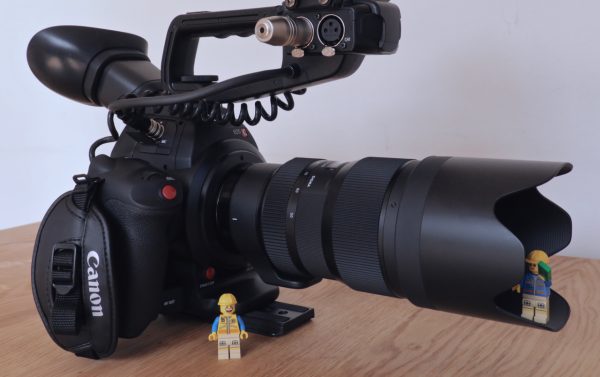
Sigma’s announcement earlier this year of their new 50-100mm f/1.8 ART was understandably met with a lot of excitement. Should the new zoom live up to the standards set by its older (though shorter) sibling, filmmakers desiring the shallow depth of field and optimal image quality offered by primes could very well find themselves heading out on a shoot with only two lenses in their kit bag.
For the sake of argument, let’s compare the two Sigma APS-C zooms to a full set of Zeiss Compact Primes – of which there are eleven in total. The Sigma 18-35mm and 50-100mm focal range covers nine of the German company’s most portable cine primes! Consider the fact that these nine Zeiss lenses range in max aperture from only T3.6 down to T2.1 and that a set of just seven of them would set you back something in the region of $25,000 to buy outright and any qualms you may have about my comparison get thrown into perspective (Ed – although almost all Zeiss CP2 lenses do cover full-frame). Any filmmaker needing a versatile kit that covers a multitude of focal lengths without compromising on lens speed, sharpness or image consistency is presented with the possibility of an affordable, relatively compact, hassle-free and indeed very compelling alternative to a “full” set of primes in the Sigmas.
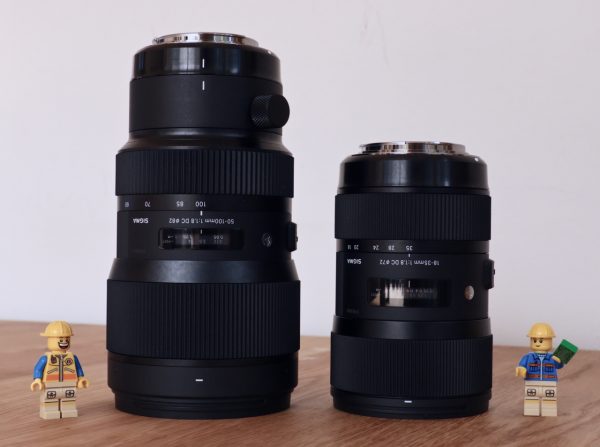
For the corporate and documentary work we do at Lintelfilm, zooms are a no-brainer. I’m as partial to shallow depth of field, crispness of image and pleasing bokeh as the next 21st century videographer. However, when your job involves activities like chasing a group of school kids around a disused lead mine in wilds of the English dales, or interviewing a succession of very busy and high-powered architects and government employees in a location you’ve been presented with only minutes before shooting must begin, zooms are frankly a necessity and primes an impractical luxury.
Of course I’m not suggesting the Sigma f/1.8 zooms offer everything a set of true cinema primes do, but for a one-man-band shooting on-the-fly, factual video, they offer a massive step toward achieving that wonderful ‘sharp and fast’ prime aesthetic. The 18-35mm ART has been my go-to lens in all but the most run and gun situations for a long time now and bar the luxury of image stabilisation there is very little about it I would change.
So have Sigma done it? Does the 50-100mm measure up to its older, shorter sibling? In the short time I’ve had to play with it my conclusion is, annoyingly, both yes and no.
In terms of image quality it is very clearly the equal of the 18-35mm. Any concerns about sharpness can be forgotten. As I’m shooting this at 1080P on a C100 mkII I’ll not offer any resolution test charts but I can confidently say it’s at least as sharp as any lens I’ve personally used (yes, even wide open). To my eye it’s also very well matched in character to the 18-35mm. Both lenses have nine rounded aperture blades which results in consistent and pleasant bokeh throughout the range of focal lengths. Naturally the longer lens produces a more pronounced subject/background separation than its wider counterpart, but the overall feel of the image appears very similar indeed.
In terms of build quality it meets the high standards we’ve come to expect from Sigma’s ART line: rugged plastic housing, a brass mount and wide rubber focus and zoom rings. As with the 18-35mm f/1.8, the zoom ring of the 50-100mm is very smooth and – unlike the wider lens – the new telephoto is practically parfocal so offers the option of effective in-shot zooming. I’ve found myself using this quite a bit so far. The focus ring too is smooth and nicely dampened so responds well to manual focusing. Focus throw is similar to the 18-35mm at somewhere between 120-150 degrees, which personally is about what I like.
On my C100 Mark II using DAF, the 50-100mm focuses accurately and very quickly – the latter not necessarily a good thing for video, but I do find it to be smooth nevertheless. It’s not a quiet lens to use in AF mode – the stepping of the motor is perhaps a little louder than its 18-35mm counterpart.
As a filmmaker working with a Super 35 sensor it’s very hard to criticise a lens like the 50-100mm f/1.8 ART. Those of you shooting video on full-frame cameras such as an Sony a7S, Canon 5D or Nikon D810 however have a choice of several high quality f/2.8 zooms – some of which have the luxury of image stabilisation and native autofocus. Putting an f/2.8 in front of a full frame sensor gives a near equivalent depth of field to f/1.8 on Super 35.
For those of us using Super 35 (or smaller) sensors, the Sigma f.1.8 zooms are absolutely unique in the market. As such it seems almost petty to talk about “cons” when reviewing the ART line’s latest zoom. However, Sigma set the bar very high with their 18-35mm and there are a small number of differences to the 50-100mm that may disappoint some hoping for exactly the same lens albeit perhaps in slightly longer form.
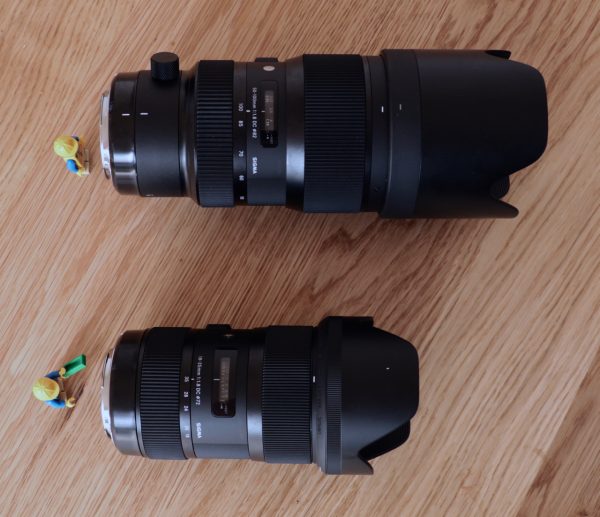
The first thing I noticed when the 50-100mm arrived was that it’s big and it’s heavy. Not too big or too heavy, but heavy enough that Sigma opted to add a carrying strap to the bag they include with the lens. Whereas the 18-35mm weighs in at about 800g and the average weight of the ART lineup is around 750g – with none of them previously going above 1000g – the 50-100mm touches almost 1500g.
Making its weight even more noticeable is the fact it’s also quite front heavy, which accentuates the way it throws off the camera’s centre of balance. On my C100 it’s just about manageable handheld (though admittedly I don’t have the steadiest hands). To give an idea of its front weighted bias, the front filter thread is an oversized 82mm – another potential downside for those hoping to use their 77mm or smaller ND filters. I wouldn’t like to put the 50-100mm on a hybrid such as an A7RII or a GH4 and frankly on an a6300 it would be ridiculous.
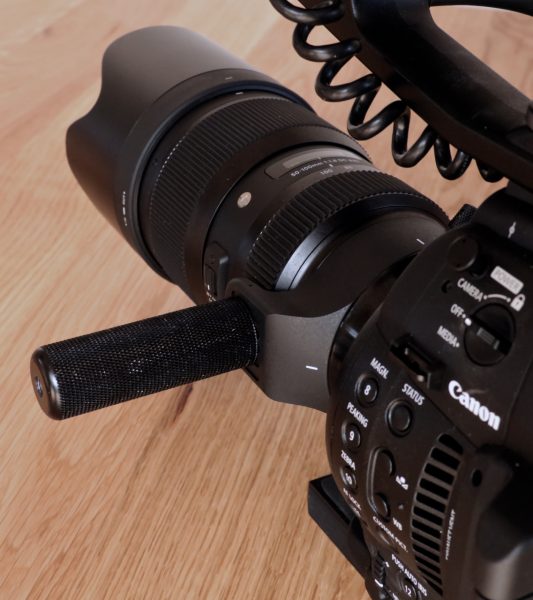
While image stabilisation would have been a nice addition to the 18-35mm, it feels just a little closer to a necessity on the longer zoom so this may steer even some S35 shooters toward opting instead for an f/2.8 zoom with IS. Of course the flipside to all of this is that the weight of the 50-100mm helps to reduce micro-jitters somewhat and at a maximum of 100mm it’s not the longest telephoto zoom out there. My results shooting handheld with the C100 have been acceptable at shorter focal lengths.
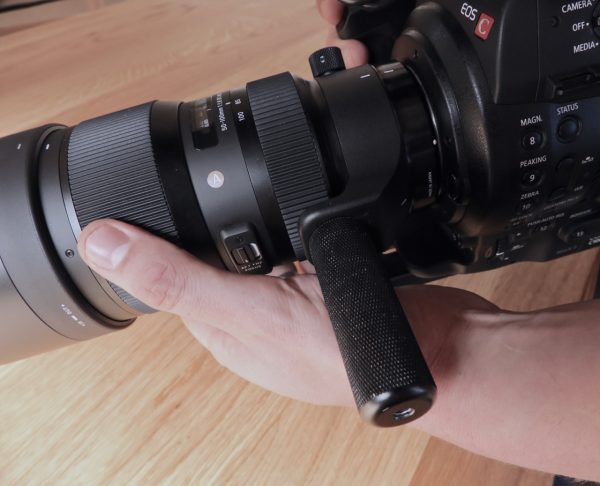
To list a final handful of observations: I find focus breathing more noticeable with the 50-100mm than the 18-35mm, but this likely a result of the greater perspective compression of a longer lens rather than a design inconsistency. Minimum focus distance is just shy of a metre but this is to be expected with a fast telephoto lens and I think on the better side of average.
Despite Sigma’s application of a ‘Super Multi-layer Coating’, flare and ghosting has been reported elsewhere as an issue – however the large included lens hood helps keep it to a minimum and in my very rudimentary tests so far I’ve not found it a big problem. (Ed – This may be more of a problem for users who need to use screw-on variable ND filters).
Of the potential downsides discussed above, for me none are dealbreakers. As a longtime fan of the 18-35mm f1.8 I’ve been waiting for a counterpart fast tele-zoom from Sigma for quite a while. Like many I made do with a selection of primes instead, but my old 50, 85 and 100mm Nikkors will now be consigned to the cupboard. For true run and gun situations I will use the excellent Canon XC10 or Canon STM zooms (for their IS and superb autofocus). Ninety nine percent of the time the 50-100mm f/1.8 ART will be used on a tripod (or at very least a monopod) and primarily as a portrait lens for interviews, but also I’m sure for some nice creamy, shallow-DOF B-roll.
In conclusion, for me the 50-100mm f/1.8 ART is indeed a winner and another classic zoom from Sigma. Despite the fact it’s almost double the weight of its wider counterpart it’s not prohibitively large or heavy on a medium sized camera. It stays true to the 18-35mm’s short but substantial legacy of superb image quality and anyone still under the spell of the older lens should not be disappointed with this much-hoped-for addition to the Art lineup. The fact it’s practically parfocal with a smooth manual zoom ring will no doubt please a lot of filmmakers. The 50-100mm is sharp as a tack, fast as hell, has a lovely clean-but-not-clinical character and is very well built indeed.





